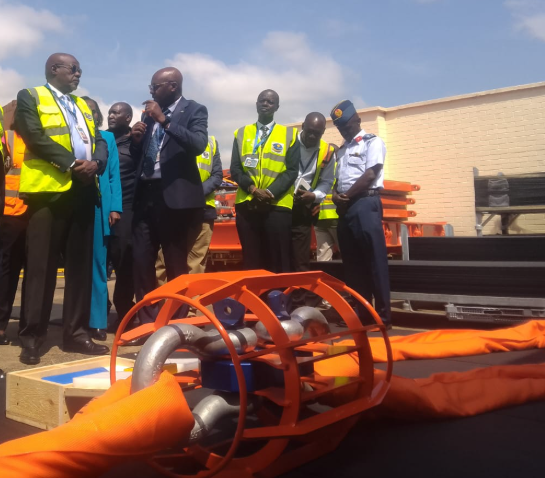
KENYA has invested in a new generation aircraft recovery system at the Jomo Kenyatta International Airport, in what is expected to be a game changer in handling stalled aircrafts at the facilities’ sole runway.
The equipment has been procured by Kenya Airports Authority (KAA) with AMS Aircraft Recovery Ltd (UK) and International Partnership for Services East Africa (IPSEA) as the delivering entities.
According to AMS Aircraft Recovery Limited managing director Yudie Fishman, the contract involves delivery of the recovery system (equipment) and training of KAA personnel, which has seen KAA invest slightly above £1,000,000 (Sh177.4 million).
“All of the equipment came from our UK operation which services commercial airlines and airports. It is a complete suite of equipment that could handle any scenario, a wide-body jet in the most serious incident,” Fishman said during the commissioning at JKIA on Friday.
This landmark investment significantly enhances Kenya’s emergency preparedness and strengthens the nation’s position as a leading regional aviation hub.
The New Generation Aircraft Recovery System is a critical asset that will allow the swift and safe removal of disabled aircraft from airport runways and taxiways, minimising operational disruptions, protecting lives and assets, and ensuring rapid resumption of normal operations.
“The commissioning of this recovery system is not only about emergency preparedness. It is about business continuity, competitiveness and protecting Kenya’s growing aviation industry,”Roads and Transport CS Davis Chirchir said in a speech read by KAA chairman Caleb Kositany.
“With this system in place, JKIA joins a select group of African airports with world-class recovery capabilities, proof of our resolve to meet ICAO standards and uphold global aviation safety benchmarks.”
The new recovery equipment, designed and manufactured by AMS Aircraft Recovery, includes advanced lifting, towing and aircraft support systems tailored for aircraft immobilised due to gear collapse, veering off runways, or other incidents.
KAA personnel have undergone intensive training both in Kenya and the United Kingdom to operate the new system effectively.
“This investment marks a major step forward in our efforts to enhance safety and operational resilience,” Kositany said, “ We want to be able, with this equipment now, to clear the runway faster than any other time before. Within an hour of an incident, we should be able to resume flights and carry on with operations normally.”
JKIA has one runway and previous incidences has seen flights delayed by hours.
For instance last Sunday, an aircraft coming to land at JKIA had experienced a tyre burst and was forced to circle, empty fuel tank before an emergency landing. The incident disrupted services at JKIA for about two hours.
The new equipment, Kositany said, ensures that KAA is fully equipped to manage complex emergencies and reinforces the authority’s commitment to delivering safe, efficient and world-class airport services.
This milestone forms part of KAA’s broader strategy to strengthen airport safety infrastructure. Other recent investments include modern aviation fire trucks, a mobile emergency command unit, and the transition to environmentally friendly firefighting foam ahead of most African counterparts.
Globally, airports are urged by ICAO to maintain robust Disabled Aircraft Removal Plans (DARP). With this commissioning, JKIA becomes a benchmark facility in the region for recovery preparedness and emergency response excellence, joining the likes of New York’s JFK Airport and London’s Heathrow, on recovery systems.
Data from the International Civil Aviation Organization (ICAO) and other global recovery experts reveal that approximately 150 incidents involving disabled aircraft occur globally each year.
These result in airport or runway closures averaging 17 hours, with some recovery operations lasting up to seven days.
Kenya has not been immune to such events. From aircraft veering off runways to technical immobilisation, each incident on the single operational runway at JKIA has triggered delays, diversions and even temporary shutdowns, with major cost implications.
JKIA is the main point of entry by air into the country, a key facility supporting the country’s economy with sectors such as tourism and trade being key beneficiaries.
It also plays an essential role in regional travel, cross-border movement and domestic connectivity.
Last year, JKIA handled 1,622,745 inbound tourists which accounted for 67.8 per cent of the total arrivals, while Moi International Airport in Mombasa recorded 204,538 arrivals, accounting for 8.5 per cent, Tourism Ministry data shows.
JKIA and MIA have the highest actual traffic, with JKIA seeing a significant share of holiday travellers (48.7%) and business (24.2%), while MIA is overwhelmingly dominated by holiday or leisure visitors (89.8%).
JKIA is served by over 40 passenger airlines and 25 cargo airlines, connecting Kenya to over 50 countries.
KAA has over the years invested in aviation safety and disaster response. Since 2015, it has implemented a number of projects among them procurement of modern aviation fire trucks and protective gear, transition to environmentally friendly fluorine-free firefighting foam, ahead of most airports in Africa, acquisition of a modern emergency mobile command system and now, the new generation aircraft recovery system, among other key investment.











